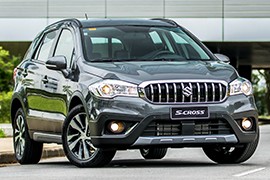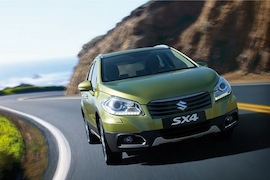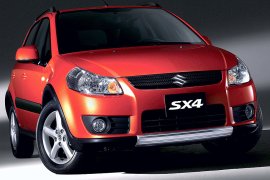SUZUKI SX4 Crossover Models/Series Timeline, Specifications & Photos
First production year: 2006
Engines: Gasoline, Diesel
Body style: SUV (Sports Utility Vehicle)
With the low sales of the SX4 S-Cross released in 2013, Suzuki decided to refresh the model to attract more buyers.
The new SX4 S-Cross was heavily redesigned and unveiled a completely new front end. The hood was raised and the nose became more upright, giving it a “stronger and bolder road presence” as Suzuki stated.
The rather anonymous grille we’ve seen on the previous model was replaced with a bigger chrome grille with vertical bars, the bumper was refreshed and the headlights suffered significant changes.
At the back, the SX4 S-Cross came with a redesigned bumper and slightly different taillights.
The major upgrade was meant to bring the SX4 S-Cross closer to an SUV’s design and capabilities.
The interior didn’t come with major updates, however, the quality of the materials was improved with softer plastics and optionally available brighter materials throughout. The cabin was still left with materials that were easy to scratch, but looked well finished.
The infotainment system available on the SX4 S-Cross was borrowed from the Vitara and it was bigger and more responsive.
The practicality offered by the SX4 S-Cross was hard to beat, as the space available was bigger than in the most crossovers. The crossover could easily accommodate up to 5 tall adults.
The trunk size was increased with the help of the reclining backrest and was up to 440 liters.
The ride was enhanced by the stiffer body and the tweaked suspension, and although a bit of body roll was noticeable at higher speeds, the SX4 S-Cross had a good grip and easy agile enough to offer a fun ride.
The Suzuki SX-4 S-Cross was the second generation of the small crossover from the Japanese manufacturer and it wasn't built together with Fiat, like the first generation.
After Fiat stepped back from its joint venture with the Suzuki in making small crossover vehicles, the Japanese company decided to move forward on its own and creating the second generation of the SX4 S-Cross. The vehicle was closer to the C-segment of the sport-utility vehicles, but it was still a cross-over. A mix between the small class and a compact SUV.
When the designers increased the size of the vehicle, the A-pillars were moved back to amplify the 2-volume design instead of the MPV-look of the first generation. It was taller and had a bigger wheelbase, to offer more legroom for the rear passengers. The new headlights could have been fitted with Xenon lamps and LED daytime running lights.
The interior was good for five people, but the central transmission tunnel was to intrusive into the cabin and thus, the middle passenger from the back seat wasn't very comfortable with the seating position. But for four passengers was more than enough, especially if the car was not fitted with the panoramic roof.
The SX4 S-Cross featured 2WD as standard, but an electronically-controlled all-wheel-drive system was offered as an option. The rear independent suspension was available only for the all-wheel-drive system.
Suzuki used its experience in producing 4x4 vehicles as part of Fiat's agreement to produce the SX4 in Europe.
The common project was a bigger hit for Suzuki than for Fiat since the Japanese brand sold twice as many vehicles as the Italian brand in the first production year. Its name was far more known in the off-road vehicles than Fiat, and that gave them an advantage. On top of that, the SX4 was sold on more markets and was fitted with a wider choice of engines.
Giorgetto Giugiaro designed it, and it might be one of the biggest mixes on the market at those times. It featured a bodywork, which was a mix between a station wagon and a minivan, a ground clearance bigger than a compact vehicle, and smaller than a 4x4. Its front fascia resembled the one on the Swift range, with horizontal slats and a wider mid bumper section.
Inside, the SX4 offered ample headroom for five passengers and higher-mounted seats, which led to better legroom. The rear seats featured a split-folding and tilting mechanism to expand the otherwise small trunk. A three-dial instrument cluster with four gauges provided the necessary information to the driver.
Apart from the Fiat-sourced engines (1.6-liter gasoline and a 1.9-liter turbodiesel), Suzuki installed its own versions with gasoline and turbodiesel units. Moreover, it offered a few versions fitted with an automatic transmission. Fiat and Suzuki developed a semi-independent rear suspension for both all-wheel-drive and front-wheel-drive systems.


